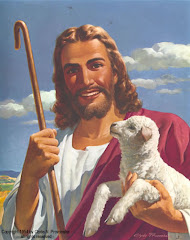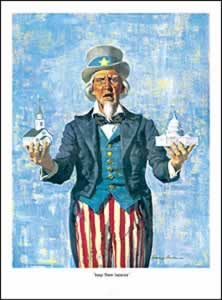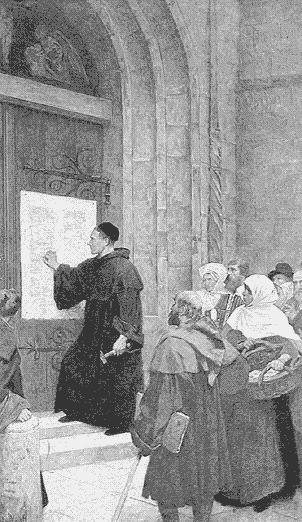"At first blush, Jeremy Rifkin would hardly seem to be talking about Dominion Theology. After all, he advocates the paradigm of 'entropy.' Our mission as humans, this New Ager says, is to 'dress and keep the earth.' Rifkin calls this the "stewardship paradigm.' The Dominion theologians, on the other hand, such as Rushdoony and Gary North, say that our mission is to 'subdue the earth.' What do these two have in common? It is the pointing of their respective camps into preparation for revolution at approximately the same time, with both sides being convinced they will control the outcome. Both planned a significant role for the charismatics in advancing their mission.... While Dominionist theologian Gary North has been critical of Rifkin, he has nonetheless been following a Rifkinesque scenario of bringing the revolution he envisions to birth – both in terms of planned use of evangelicals and charismatics."
–Constance Cumbey, "THE PLOT TO USE THE CHARISMATICS"
What does the Emergent Church have in common with the New Apostolic Reformation? Everything! They are two sides of the same coin.
The same template has been followed for both – the very sameblueprint was used from day one. The rising political power and influence of the New Apostolic Reformation, and the simultaneous growth of the Emergent Church movement, is no accident. It was planned all along. And New Ager Jeremy Rifkin wrote the "blueprint" for it!
This blueprint for an "emerging order" was published as a book, significantly in the year 1979, just after the Evangelical Consultations on the Future,[2] and before the rapid rise of the political Right in the early 1980s. Titled The Emerging Order: God in the Age of Scarcity,[3]Rifkin's book, at first blush, appears to be a manifesto for environmental stewardship. And that is indeed one of its objectives. But that's not its full purpose, as New Age expert, author Constance Cumbey, noted. She wrote about it in her book A Planned Deception,[4] where she explained how Rifkin had passed himself off as a Christian during the era in which The Emerging Order was published:
"Rifkin has deceived many Christians and he has used his friendship with Pat Robertson to help do it. In 1980 Robertson praised Rifkin'sEntropy unpublished manuscript. (p. 157)
"Pat Robertson sent a newsletter endorsing that book while it was still an unpublished manuscript! Pat Robertson's Perspective of June/July 1980, rather than exposing this horrible threat to Christianity, almost made it sound Christian...." (p. 161)
Cumbey detailed the many New Age connections and philosophies embraced by Rifkin, and then explained that "Rifkin also wrote The Emerging Order. There he made it clear that the evangelical church would be their primary instrument to bring the new world order to birth." (p. 162)
Rifkin's book was touted as a blueprint. The cover jacket for The Emerging Order states, "In this provocative book, the authors provide a blueprint for American culture that is staggering in its implications. Beyond being yet another indictment of the liberal welfare state, their thesis points to a major cultural reformation in which religion will play a leading role in the rearrangement of our nation's priorities."
The book was also called "a blueprint for the economic and spiritual challenges facing the Christian community in the remainder of this century" by Senator Mark Hatfield, a key member of the secretive Washington Fellowship ("The Family").[5] Hatfield's endorsement of the book may become increasingly significant.
A "second Protestant reformation" –
"a great religious awakening"
In the introduction to The Emerging Order, Rifkin lays out hisblueprint, stating that he believed that "we are in the early morning hours of a second Protestant reformation" which is evident by "the shift now taking place in Protestant doctrine."(p. ix) In the late 1970s, noticing the rapid rise of "church renewal" that was taking place across America, he expressed the hope that this event would "give form to a new theological construct; one whose sweep is so broad that it could well consume the theological world view of the Reformation." (p. ix) He wanted to hitch a ride on the renewal train, and his blueprint told how to commandeer the train and turn it onto a new track.
This seemed impossible at the time. But Rifkin outlined a specific plan. He proposed jumpstarting a "second Reformation" with the missing element of mysticism. The emphasis on the "supernatural" would "provide a bridge" to acceptance of both new doctrines and a global economic transformation, he suggested. The basic blueprintfor using mysticism was articulated as follows:
"Today's Christian renewal movement is a two-pronged phenomenon. First, there are the millions upon millions of Charismatics, whose belief in supernatural gifts of faith healing, speaking in tongues, and prophesy represents a monumental assault on the modern age itself. For the Charismatics, these supernatural powers are beginning to replace science, technique and reason as the critical reference points for interpreting one's day-to-day existence. If this unconscious challenge to the modern world view continues to intensify, it could provide the kind of liberating force that could topple the prevailing ethos and provide a bridge to the next age of history." (p. x)
The blueprint also called for a corresponding more rational approach, a pseudo-intellectualism that could concoct new doctrines, especially doctrines that would lead Christians to embrace a "new covenant vision" and a "new world view."
"While the Charismatics are generating a potential liberating impulse, the more mainline evangelical movement is beginning to provide the necessary reformulation of theological doctrine that is essential for the creation of a new covenant vision and a new world view." (p. x)
What was to be the key doctrinal shift for this Emerging Order? Rifkin identified Dominionism, especially the early chapters in Genesis, as the core doctrine that must be "redefined." The process of "redefining" Dominionism is explained in this manner:
"God's very first commandment to humankind in the book of Genesis is being redefined. Its redefinition changes the entire relationship of human beings to both God and the temporal world. In the beginning, God says to Adam 'have dominion over the fish of the sea and over the birds of the air and over every living thing that moves upon the earth.' 'Dominion,' which Christian theology has for so long used to justify people's unrestrained pillage and exploitation of the natural world, has suddenly and dramatically been reinterpreted. Now, according to the new definition of dominion, God's first instruction to the human race is to serve as a steward and protector over all of his creation." (p. x)
Note how easily this "redefinition" of Dominion caught on. There was virtually no opposition to this heresy!
"It is interesting to observe that this most fundamental reconception of God's first order to his children on earth has been accepted by Protestant scholars, ministers and practitioners in just a few short years without any significant opposition being voiced. In fact, one would be hard pressed to find a leading Protestant scholar anywhere today who would openly question this new interpretation of dominion in the Book of Genesis.... While it is true that the new interpretation of dominion is also being promulgated by the mainline Protestant denominations and the Catholic Church, it is the evangelical community, with its resurgent spiritual vitality, that has the momentum, drive and energy that is required to achieve this radical theological transformation in American society." (p. x-xi)
Rifkin was right. Protestant and Catholic scholars had begun developing this Dominion theology. But by the mid-1970s, changing doctrines had also become a major project of Fuller Theological Seminary and its evangelical cohorts. C. Peter Wagner, Ralph Winter, and other professors began to chip away at traditional orthodoxy, slowly concocting a strange brew of ever-evolving progressive "revelations," heading towards an outright Dominionist theology. Thanks to Ralph Winter, Mission Frontiers, and the U.S. Center for World Mission, the "redefinition" teachings of Dominionism were standard fare in the global mission movement by the mid-1990s.
But all of this activity was still missing a critical ingredient Rifkin had identified as necessary to shift over to "a great religious awakening" – the mysticism. He wrote:
"If the Charismatic and evangelical strains of the new Christian renewal movement come together and unite a liberating energy with a new covenant vision for society, it is possible that a great religious awakening will take place, one potentially powerful enough to incite a second Protestant reformation." (p. xi)
Here it was, The Master Plan for the next "great religious awakening." It took one man, C. Peter Wagner, to ignite the fuse according the plan laid out in Rifkin's blueprint. Wagner became a key player in a confluence that began to have massive repercussions throughout the rest of evangelicalism. It began to take off when John Wimber of the Vineyard Movement connected with the Kansas City "prophets," part of the old Latter Rain cult. John Wimber had previously been hand-picked as an “experiment” by C. Peter Wagner as part of his Fuller Theological Seminary class on “signs and wonders.” Wimber’s connection to the Kansas City group proved to be the catalyst for the beginnings of "The Third Wave," what C. Peter Wagner was to later call the “New Apostolic Reformation.” In short order the esoteric doctrines of the Latter Rain movement trickled into mainstream evangelicaldom and gradually became an integral part of the postmodern evangelical canon. And because of Wagner’s influence, Latter Rain leaders such as Mike Bickle and Rick Joyner, who were obscure in 1991, are now widely known throughout evangelicalism. The Latter Rain cult, most notable for its anomalous signs and wonders, would pick up steam and continue to provide the necessary "powerful," "liberating energy" to fuel the blueprint.
Jeremy Rifkin's "great religious awakening" went a step further. It called for a "new Protestant conservation ethic, ready-made for the new age of scarcity the world is moving into."(p. xi) To accomplish this he called for a "great economic transformation," an "economic shift," the intended result of the "theological spark" created by "the evangelical awakening that is spreading across America and... the... second Protestant reformation emerging between now and the year A.D. 2000."(p. xii) This economic shift would be nothing less than a global redistribution of wealth. This theme was dutifully picked up by the New Apostolic Reformation as an abiding prophecy, and continues to gather steam as it co-mingles with Dominionism.[6]
There was still another missing ingredient. It took an entire generation to come up with it, but after oodles of money, gigantic publishing contracts, and massive stealth "change agent" training, Leadership Network became a leading player in the more mainstream evangelical world. It began by dialectically facilitating both components of the blueprint for transformation. It developed a church structure that modeled corporations in a form of extreme pragmatism that rewrote the basic biblical doctrines of "church." It then hijacked the consumer-driven train and turned the church into its own marketing agent for the blueprint. And it simultaneously launched the Emergent Church movement, which added the necessary pizazz of mysticism to blunt rational thought. Its leading Emergent spokesperson from early on, Brian McLaren, would serialize Rifkin'sblueprint in his successive books, each more fine-tuned than the last, systematically destroying the old order theology while laying the groundwork for the new order theology.[7]
Just how did Rifkin propose to implement such a monumental scheme? In 1980 it seemed far-fetched and nearly impossible. But the wholeblueprint is fully operational today, thirty years later, and no longer a plan but a reality.
To be continued. . . .
The Truth:
"Behold, they shall surely gather together, but not by me:" (Isaiah 54:15a)
Endnotes:
1. Constance Cumbey, "THE PLOT TO USE THE CHARISMATICS," New Age Monitor, May-July 1986, p. 11, links added. See http://cumbey.blogspot.com/ for more readings by this author.
2. See Part 4 of this series: http://herescope.blogspot.com/2010/09/concocting-great-awakening.html. The Discernment Research Group first broke this story in September 2005 in a series of posts that ran into October 2005. One can look through the posts to read more details about these consultations. http://herescope.blogspot.com/2005_09_01_archive.htmland http://herescope.blogspot.com/2005_10_01_archive.html
3. Jeremy Rifkin with Ted Howard, The Emerging Order: God in the Age of Scarcity (G.P. Putnam's Sons, 1979).
4. Constance Cumbey, A Planned Deception: The Staging of a New Age "Messiah," 1985. This rare book can now be downloaded by going here: https://public.me.com/cumbey
5. To understand the significance of this point, see Jeffrey Sharlet's two books: The Family: The Secret Fundamentalism at the Heart of American Power (Harper, 2009) and C Street: The Fundamentalist Threat to American Democracy (Little, Brown and Co., 2010). Also read "Early Experiential Emergents" http://www.crossroad.to/articles2/009/discernment/5-emerging-2.htm
6. See "The Great Outpouring of Wealth," http://herescope.blogspot.com/2010/08/great-outpouring-of-wealth.html
7. See our Herescope series "The Emerging Church - Circa 1970" and follow the links and footnotes:
http://herescope.blogspot.com/2009/05/emerging-church-circa-1970.html
http://herescope.blogspot.com/2009/05/early-experiential-emergents.html
http://herescope.blogspot.com/2009/06/retro-emergent.html
http://herescope.blogspot.com/2009/07/new-thing.html
http://herescope.blogspot.com/2009/07/emergence-towards-convergence.html
http://herescope.blogspot.com/2009/07/envisioning-emergence.html
http://herescope.blogspot.com/2009/07/quantum-eschatology.html
http://herescope.blogspot.com/2009/08/reinventing-clergy.html
http://herescope.blogspot.com/2009/08/celebrating-open-inclusiveness.html
Note: The word blueprint is emphasized throughout this article, even in quoted material.
















0 comments:
Post a Comment